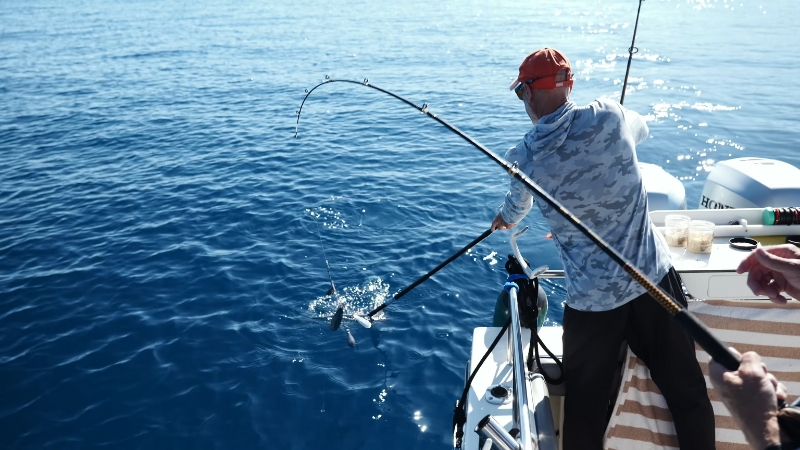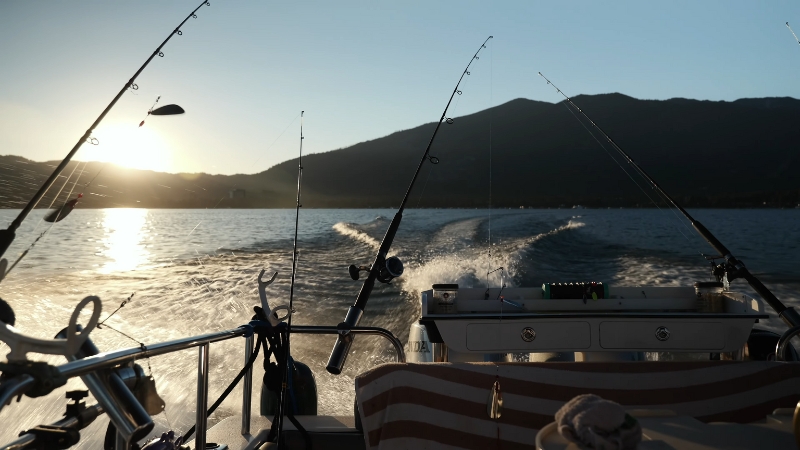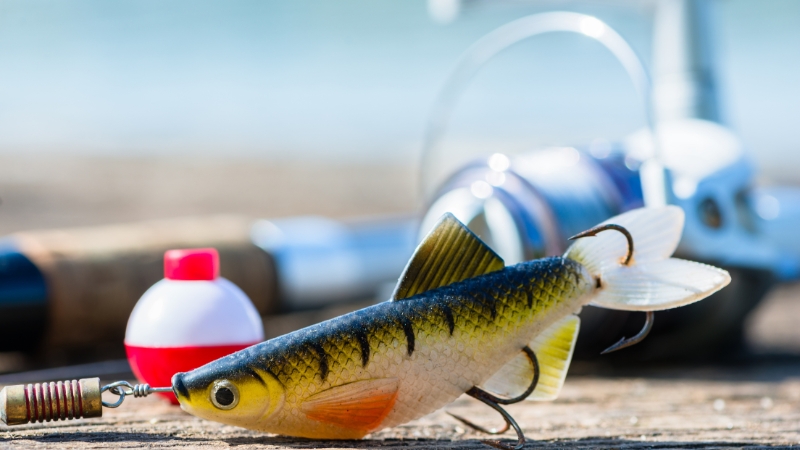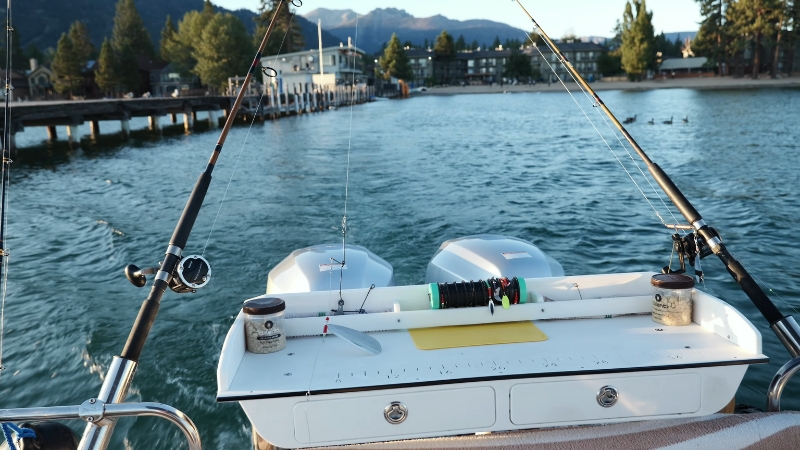A day on Lake Tahoe always feels like a small adventure. Clear water, a huge spread of shoreline, and the steady promise of trout or kokanee turn even a simple outing into something worth planning.
The lake has a mood shaped by altitude and depth. Conditions shift fast. A warm afternoon can follow a freezing sunrise, and quiet coves can turn choppy without much warning.
All of that makes preparation more valuable than people expect. A single rod and a handful of lures rarely carry you through a full day on a lake this large.
In the following guide, we will cover everything you need for a complete day on Lake Tahoe.
We’ll explain what anglers deal with around the basin, including licensing rules, safety expectations, gear for deep water fish like Mackinaw, and clothing choices that actually fit the mountain environment.
It works for shore anglers, small craft users, and people renting a boat for a few hours. The pack list is built from regional rules, state agency guidance, and common gear used by Tahoe anglers all year. Let’s get started.
A Quick Look
| Category | Gear to Pack |
| Licenses & Documents | CA or NV fishing license, ID, saved PDF regulations, waterproof notebook |
| Rods & Reels (shore) | 6.5–7.5 ft spinning rod, 2500–3000 reel, 6–10 lb line |
| Rods & Reels (boat) | Medium to heavy trolling rods, levelwind reels with 15–30 lb line, jigging combo |
| Line & Terminal Tackle | 4–20 lb fluoro leaders, swivels, snap swivels, split shot, egg sinkers, assorted hooks |
| Lures & Bait | Nightcrawlers, minnows if legal, salmon eggs, small spoons, spinners, plugs, heavy jigs, trolling spoons |
| Storage | Tackle bag, waterproof boxes, shore kit |
| Clothing | Layered system, sun hat, beanie, spare socks |
| Waders & Footwear | Chest waders, boots, deck shoes, hiking shoes |
| Sun Protection | Sunglasses, sunscreen, lip balm, sun gloves, neck gaiter |
| Safety | Life jackets, throwable PFD for boats, first-aid kit, headlamp, emergency blanket, whistle |
| Communication & Weather | Phone with offline maps, printed map, radio, power bank |
| Invasive Species Prevention | Brush, towels, mesh bag |
| Food & Hydration | Two to three litres of water, snacks, cooler, trash bags |
| Electronics | Fish finder with GPS, rod holders, downriggers, thermometer probe |
Licenses, Regulations, and Simple Documentation
Fishing without the right license can ruin a day before it begins, so it helps to start with paperwork. Lake Tahoe is shared by California and Nevada.
Anyone 16 or older needs a valid license from one of those states. You can fish the open lake with one license, although the moment you enter a tributary or move entirely into a state’s waters, the regulations shift to match that side.
- Both states allow online purchasing. California anglers use the official site at https://wildlife.ca.gov/Licensing/Fishing,
- Nevada anglers buy through: https://www.ndow.org/get-outside/fishing/.
Nevada may require a trout stamp on certain licenses, so a quick check never hurts.
Pack either a printed license or a digital version stored on your phone. Keep an ID with you, since rangers and wardens can request it.
Regulation references worth keeping
Lake Tahoe has season rules, special closure areas, and specific bag limits. Carrying full booklets is unnecessary, although having a digital copy helps.
Useful pages include:
- California Freshwater Regulations PDF
- Nevada 2025 Fishing Regulations PDF
- US Forest Service recreation rules for the basin
Save the PDFs to your phone. Write a few bag limits or size minimums in a small waterproof notebook. A pocket reference matters more than people assume, especially when you are tired or juggling gear at dusk.
Core Fishing Gear for Lake Tahoe Waters
Lake Tahoe holds lake trout, rainbow trout, brown trout, kokanee salmon, and Lahontan cutthroat trout.
Lake trout dominate deeper water and often reach sizes over twenty pounds. Gear choices depend heavily on where you stand and what you chase.
Rod and Reel Setups

1. Shore Fishing
Shore anglers usually target rainbow trout and kokanee from popular access points such as Cave Rock or Sand Harbor. A medium-light spinning rod around six and a half to seven and a half feet works well.
Pair it with a 2500 or 3000 size spinning reel with smooth drag. Spool your reel with six to ten-pound monofilament or fluorocarbon.
2. Boat Fishing
Boat anglers often troll or jig for Mackinaw. A set of medium or medium-heavy rods around seven to eight and a half feet covers most conditions.
Levelwind or low-profile baitcasting reels pair well with trolling setups, while jigging rods benefit from twenty to thirty-pound braid. Many charters provide all of this for you, although bringing your own backup gear never hurts.
Line, Leaders, and Terminal Tackle
Lake Tahoe’s clarity pushes anglers toward lighter leaders near the surface. Deeper jigging allows a stronger line without hurting success.
Main Lines to Pack
- Six to ten-pound mono or fluoro for shore trout
- Fifteen to thirty-pound braid for jigging and trolling
Leader Options
- Four to eight-pound fluorocarbon for rainbows
- Twelve to twenty-pound fluorocarbon for Mackinaw
Terminal Tackle
- Barrel swivels and ball-bearing swivels
- Snap swivels for spoons
- Split shot and sliding egg sinkers
- Hooks in sizes six through ten, along with some 1/0 to 3/0 for larger bait rigs
Lures and Bait that Consistently Work on Tahoe
View this post on Instagram
Guides around the lake rely on a blend of bait and artificial lures. Always check rules for live bait, since minnows face restrictions depending on location.
Bait
- Nightcrawlers
- Salmon eggs
- Minnows, where allowed
Shore Lures
- Small spoons in silver, gold, or blue, one-eighth to one-quarter ounce
- Inline spinners, sizes one through three
- Floating or shallow minnow plugs
Boat Lures for Mackinaw
- Heavy jigs from one to three ounces
- Trolling spoons
- Dodgers or flasher rigs
- Deep minnow plugs
- Soft plastic grub bodies that trail behind dodgers
Early light often calls for shallow lures or bait near the surface. As the sun climbs, many lake trout sink into seventy to two hundred feet of water, where temperatures around fifty-two degrees often gather them in tight groups along ledges.
Tackle Storage that Keeps You Sane
Wind and waves can scatter small items quickly. A medium or large tackle bag with removable trays keeps everything organized.
Add a few waterproof utility boxes and a small day pouch for shore spots. Shore anglers often appreciate a compact kit that fits into a backpack.
Seasonal Clothing and Personal Gear

Lake Tahoe’s mornings can feel icy, even during summer. Mountain air loses heat overnight, and the shoreline often starts with chilly wind. Layering solves most of the discomfort.
Clothing Layers for Tahoe Conditions
- Base layer: Moisture-wicking long-sleeve top. Thermal leggings for colder months.
- Mid layer: Fleece jacket, light insulated jacket, or a warm flannel.
- Outer layer: Waterproof shell jacket and rain pants for spray or sudden afternoon squalls.
- Extras: Quick-dry pants or shorts, wool socks, spare socks, sun hat, and a warm beanie for dawn.
You can round out that setup with specialized fishing clothes that keep you warm in cold dawn hours and comfortable once the sun climbs.
Waders and Footwear
Anglers who step into tributaries or stand right at the water’s edge often prefer waders. Spring and fall fishing becomes far more comfortable with insulated chest waders and stocking-foot boots.
Bring non-marking deck shoes or sandals for boat decks and lightweight hiking shoes for shoreline trails.
Sun and Weather Protection
Tahoe sits above six thousand feet. Sunburn arrives faster than expected.
Pack:
- Polarized sunglasses
- Sunscreen rated SPF 30 or higher
- SPF lip balm
- Sun gloves
- Neck gaiter
Polarized lenses help you see fish movement and cut glare on the lake’s clear surface.
Safety Gear for a Day on the Water

The agencies around Tahoe place a strong focus on safety. Cold water, sudden wind, and deep drop-offs demand some caution.
Boat Flotation and Safety Requirements
Every person on board needs a Coast Guard-approved life jacket. A throwable flotation device is required on motorized boats. Carry a whistle or horn. Navigation lights must work if your outings stretch into dawn or dusk.
Rental marinas usually include life jackets, although checking every strap and buckle before leaving the dock is smart.
Small Personal Safety Kit
A compact safety kit can stay in a waterproof pouch in your pack or dry box.
Include:
- First-aid kit
- Emergency blanket
- Headlamp or small flashlight with extra batteries
- Knife or multitool
- Waterproof matches or lighter
- Whistle
- Power bank and phone cable
Weather and Communication Tools
Cell coverage varies around the lake. Some coves drop signal entirely. A smartphone with offline map downloads helps.
A printed map of access points adds one more layer of security. If you travel far from marinas, bring a basic FRS or VHF radio.
Invasive Species and Clean-Boat Gear
Lake Tahoe protects its water aggressively. Golden mussels, quagga mussels, and New Zealand mudsnails threaten the ecosystem, so every motorized boat headed for Tahoe undergoes inspection and hot water decontamination.
Shore anglers and kayak users play a role in prevention through simple habits.
Clean, Drain, Dry Essentials
Pack:
- Scrub brush
- Towels for drying hulls and boots
- Mesh bag to keep wet gear away from dry items
Motorized boats must pass through inspection stations. You can check details and schedules here.
Food, Hydration, and Comfort Items for a Full Day
Altitude drains energy and hydration faster than coastal settings. Anglers often underestimate how quickly the sun, wind, and constant motion create dehydration.
Pack at least two to three litres of water per person. Add electrolyte packets if you will be fishing for long hours. Stick with simple snacks such as nuts, jerky, fruit, or sandwiches.
A medium cooler with ice packs keeps everything fresh. Bring trash bags so you can leave areas clean, since visitor guides around the lake highlight Leave No Trace practices.
Shore anglers often appreciate a small folding chair, a tarp or blanket, and reusable cups.
Electronics and Modern Fishing Tech
Tahoe anglers use more tech now than ever. Depth, temperature, and bottom contours play major roles in finding fish.
Fish Finder and GPS
Bring:
- Portable or mounted fish finder
- GPS functionality
- Transducer, installed or clamped
- Downloaded contour maps or a mapping chip
Rental boats may offer electronics as optional add-ons.
Accessories for Handling Deeper Water
Rod holders help keep lines steady during trolling. Downriggers or clip-on trolling weights allow you to reach deeper schools of Mackinaw.
A thermometer probe gives you insight into temperature layers. A waterproof phone case protects your primary navigation tool.
Species-Specific Gear Adjustments
The lake supports both native and stocked species. Lahontan cutthroat trout have been stocked in large numbers in recent years. That mix impacts lure size, line strength, and fish handling.
Mackinaw (lake Trout)
- Medium-heavy rods
- Twenty to thirty-pound braid
- One to three ounce jigs
- Trolling gear with downriggers
- Large net for fish over twenty pounds
Rainbow Trout
- Medium-light spinning rod
- Four to eight-pound fluorocarbon leaders
- Nightcrawlers, salmon eggs, or dough bait where allowed
- Small spoons and spinners
Kokanee Salmon
- Light trolling setups
- Small dodgers with hoochies or tiny spoons
- Six to ten pound main line
- Corn-tipped hooks in some regions, depending on regulations
Lahontan Cutthroat Trout
- Spinning setups similar to rainbow trout
- Larger spoons or streamers
- Gentle handling to support restoration work
Always check current size limits and bag rules for whichever side of the lake you fish.
Shore Versus Boat & What Changes in Your Pack

A shift from shoreline casting to time on the water changes what you carry. The basics stay familiar, although each approach asks for a different mix of gear, weight, and backup items.
Shore-Specific Packing
Shore anglers usually carry one rod, a compact tackle bag, a folding chair, and waders for spring and fall.
A small cooler and strong sun protection make long afternoons more pleasant. Add a few towels and clean, drain, dry gear for waders and boots.
Packing for A Boat Day
Boat trips increase your list. Add:
- Extra rods
- Trolling hardware
- Larger cooler
- All safety equipment
- Electronics and backup power
- Spare layers for wind and spray
Charters often supply rods, reels, bait, and even fish cleaning services, although you still bring clothing, licenses, hydration, and personal comfort gear.
Final Thoughts
@bens_drawings Beautiful catch!! #fishing #laketahoe #fish #trout #lake #fishinglife #mountains ♬ original sound – Ben Osborn
A full day on Lake Tahoe calls for gear suited to deeper water, clear light, and mountain weather. Small choices, like lighter leaders in shallow water or extra layers for cold dawn hours, often shape how your day feels.
With the list above, you can move from shore fishing at first light to deep water trolling later in the day without scrambling for forgotten items.
Pack smart, follow local rules, and give yourself enough room for a full day on one of the most remarkable freshwater lakes in the region.

